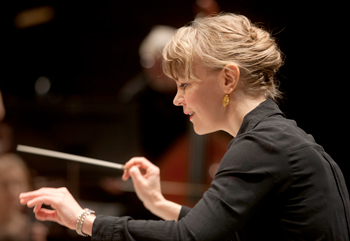by Mike Telin

Mälkki is currently in her fourth season as Chief Conductor of the Helsinki Philharmonic Orchestra and her third season as Principal Guest Conductor of the Los Angeles Philharmonic. In December of 2016 she made her debut at The Metropolitan Opera leading the premiere of Kaija Saariaho’s L’Amour de loin. A recipient of the Pro Finlandia Medal of the Order of the Lion of Finland in 2016, the following year she was named Musical America’s Conductor of the Year.
On Thursday, February 6 at 7:30 pm, Mälkki will return to the Severance Hall podium to lead The Cleveland Orchestra in Sibelius’ En Saga and Symphony No. 1.
Mälkki will be joined by Leila Josefowicz to pay tribute to their mentor and friend Oliver Knussen with a performance of the late composer/conductor’s Violin Concerto. The program will be repeated on Saturday, February 8 at 8:00 pm. Tickets are available online.
Due to scheduling and time zone conflicts, a telephone conversation with the conductor was not possible, however Susanna Mälkki graciously offered to respond to questions via email. (An interview with Leila Josefowicz will follow on Wednesday).
Mike Telin: Your program is very interesting: is there a thread that connects the three pieces?
Susanna Mälkki: I guess we could say that the young Sibelius creates a frame for a composer of our own time, who also has a language of his own, rooted in the tradition but yet original.
MT: As you know, Sibelius always declined to cite a literary source for En saga. Do you think it needs a story? If so, what is yours?
SM: I think it was wise of him, actually, not to limit the imagination of the listeners. ‘En saga’ means ‘a tale’ and I do find a certain journey-like path in it. Not wanting to be too precise, it could be telling a story about a dream or attempt which is abruptly broken. It’s an incredible example of Sibelius’ ability to immediately transport us to his landscape — at least for my very Finnish ears!
MT: I enjoy Sibelius No. 1 very much. What do you find attractive about the piece?
SM: I love the contrasts and the certain ‘moodiness’ of it, looming behind the beautiful music. And as in En saga, it also tells stories inside the stories within each of the movements. No doubt the work is very strongly connected to the Romantic tradition, but the more original Sibelius is already present, and I think it’s important to give space for those elements as well.
Sibelius is sometimes heard and even played with a rather ‘sugary’ manner out in the world, but in my opinion it does contain a lot of darker sides too, and a directness.
MT: What interpretive challenges does it present?
SM: In addition to not letting the characterization fall into traps of sweetness but keeping the sincerity, the tempo changes defining structure are one of the most fascinating aspects in all of Sibelius.
MT: Could you say a few words about your professional relationship with Oliver Knussen?
SM: I was very lucky to have known him, and even if we didn’t keep in touch that regularly, he was a very important mentor to me, and his support was priceless. His ears were extraordinary. So was his encyclopedic knowledge, and his exceptionally high ethics about conducting — really ‘polishing’ music for the ears and never buying into any superficial gimmicks — were an enormous encouragement and a model.
MT: I will be speaking with Leila soon, but I’d like to hear your thoughts on the violin concerto.
SM: This concerto is a true gem. It’s very concentrated — short — but contains so much! On the first hearing, there’s a lot to take in in the external movements (full of counterpoint) and of course extraordinary beauty in the slow movement, but it’s also a work which unveils more and more each time. Therefore, I’m certain that it will stay in the repertory as one of the most important concertos of our time.
MT: You and Leila have collaborated many times to great acclaim. What makes the partnership work so well?
SM: I admire her work, her playing, her extraordinary instrumental skills, and her bewildering musical sensibility. It’s fantastic to perform with her, since her presence is so strong and her awareness of the present moment so palpable. We both love great new music and share this commitment to it. Truly inspiring!
MT: You made your Cleveland debut in April of 2015. Many great things have happened in your career since then — congratulations. What are some of your personal highlights between then and now?
SM: Thank you, I’m so pleased. It’s indeed been quite amazing, and definitely having had a chance to work so often with orchestras of the highest level, such as The Cleveland Orchestra, is also something that has enriched my music-making, so I’m so grateful to them all. What to mention? There are debuts, like the Met, such a legendary house, starting my relationship with the Helsinki Philharmonic, and building on the tradition of my own musical roots. And of course the LA Phil, but the most extraordinary journey is in the music itself, always.
MT: Orchestras have personalities — how would you describe Cleveland’s?
SM: I have been deeply impressed by the ensemble-like quality of the orchestra and their refinement. You can find excellent musicians in many places, but to find a team which also has such incredible ability to play as one is rare — I’d say quite unique.
MT: Please feel free to add anything you think would be of interest to the readers.
SM: I am immensely looking forward to the week!
Published on ClevelandClassical.com February 4, 2019.
Click here for a printable copy of this article



